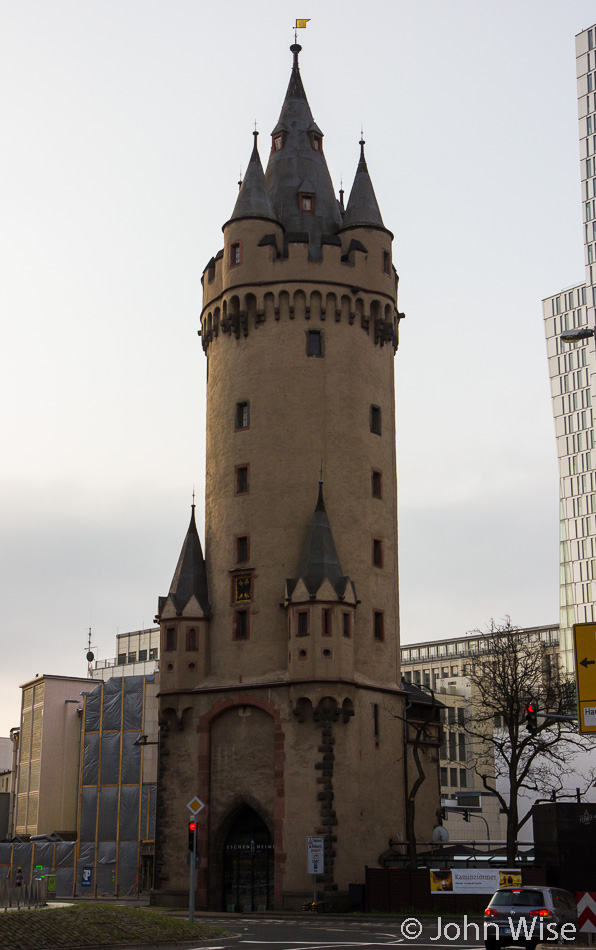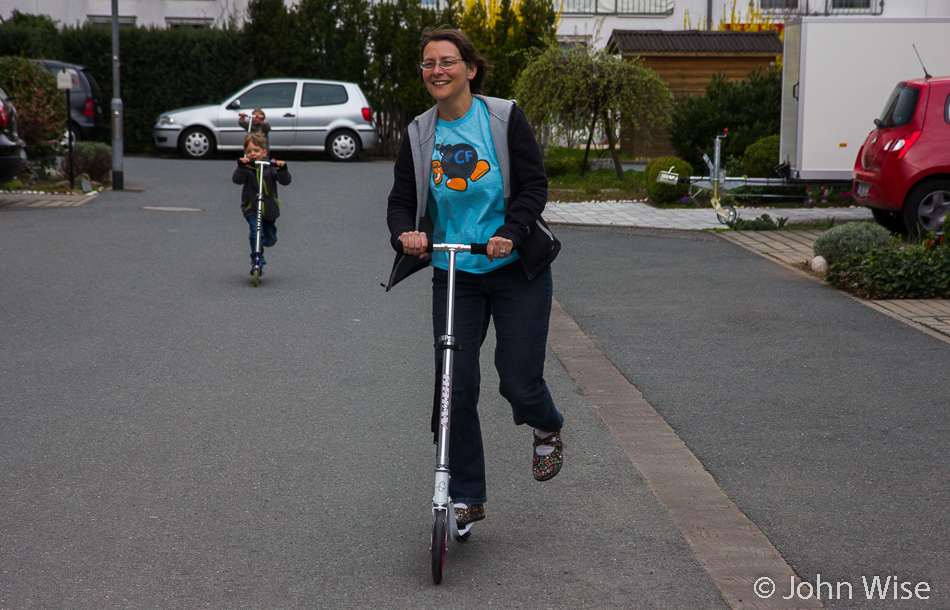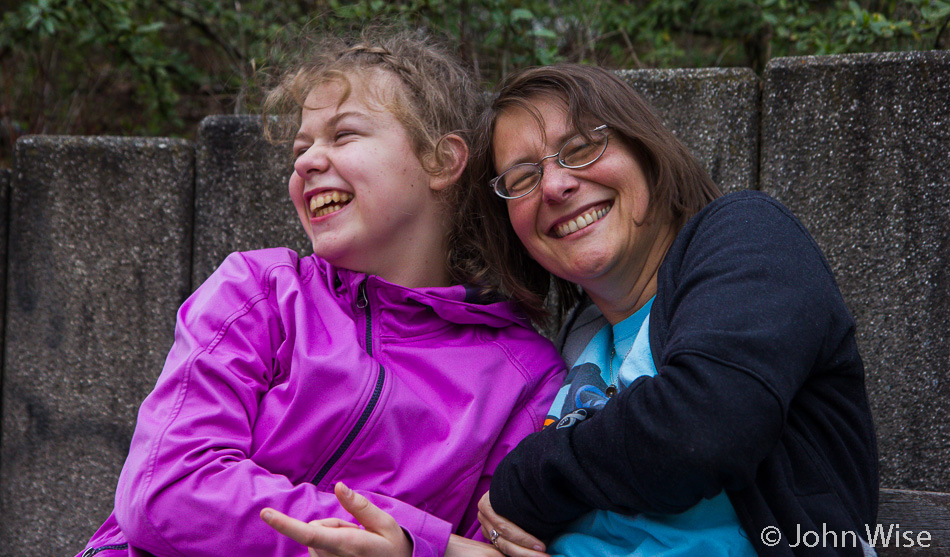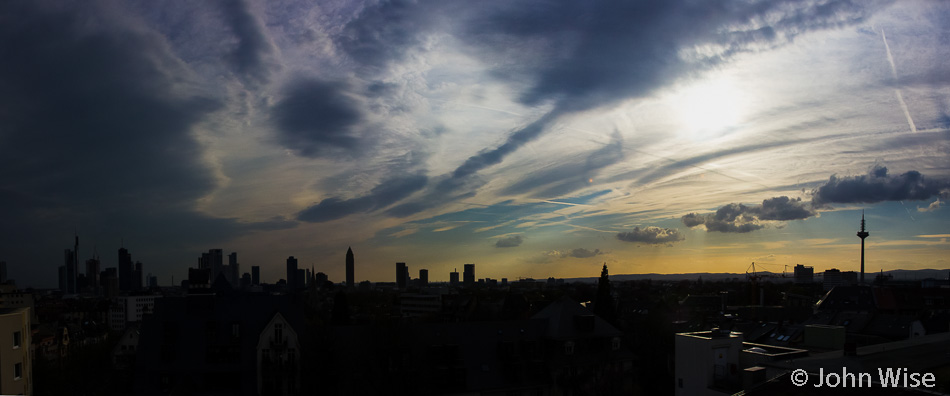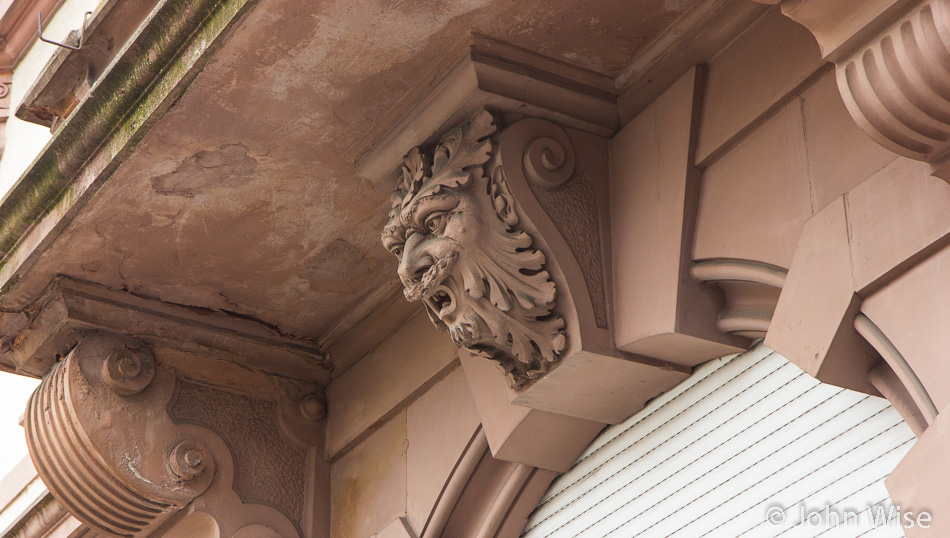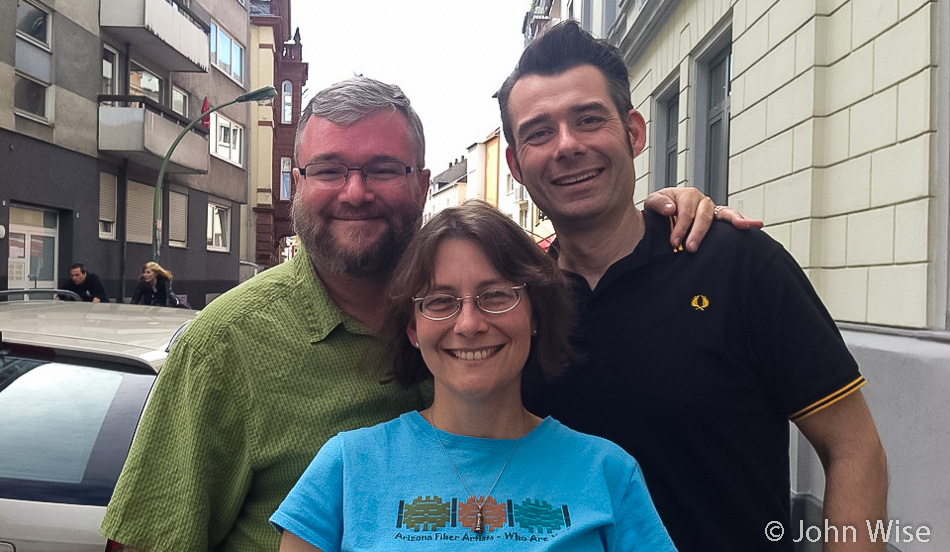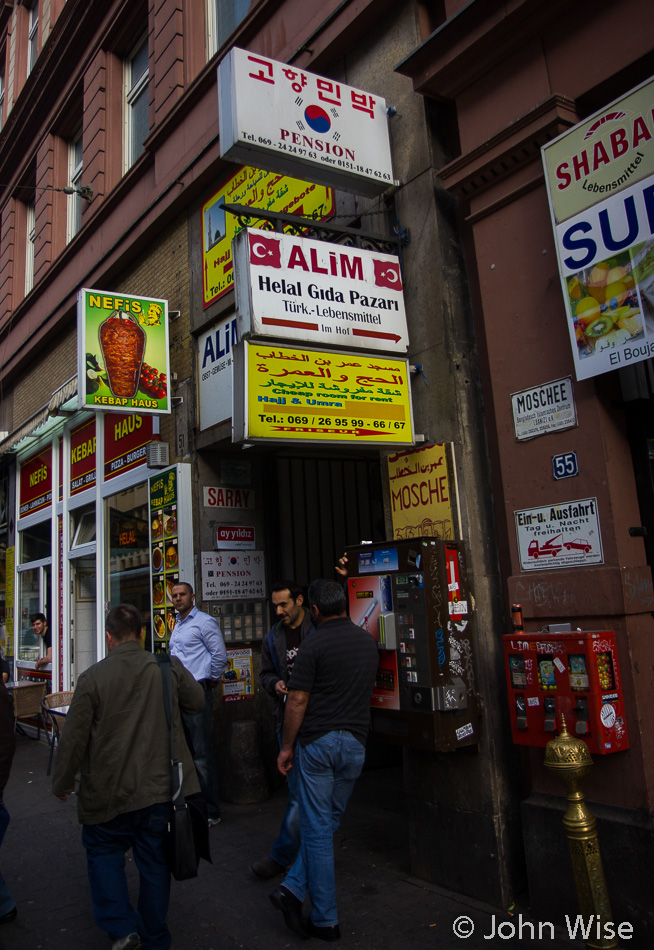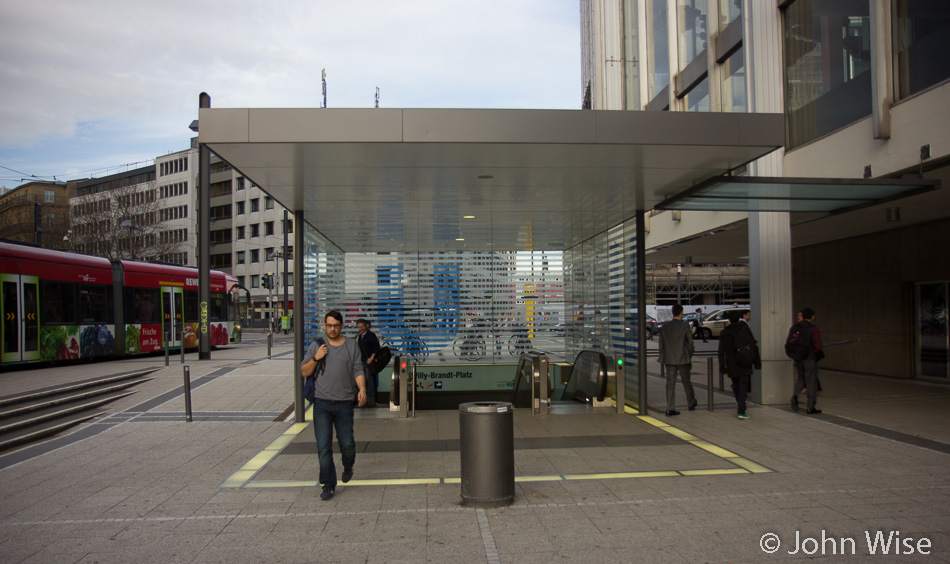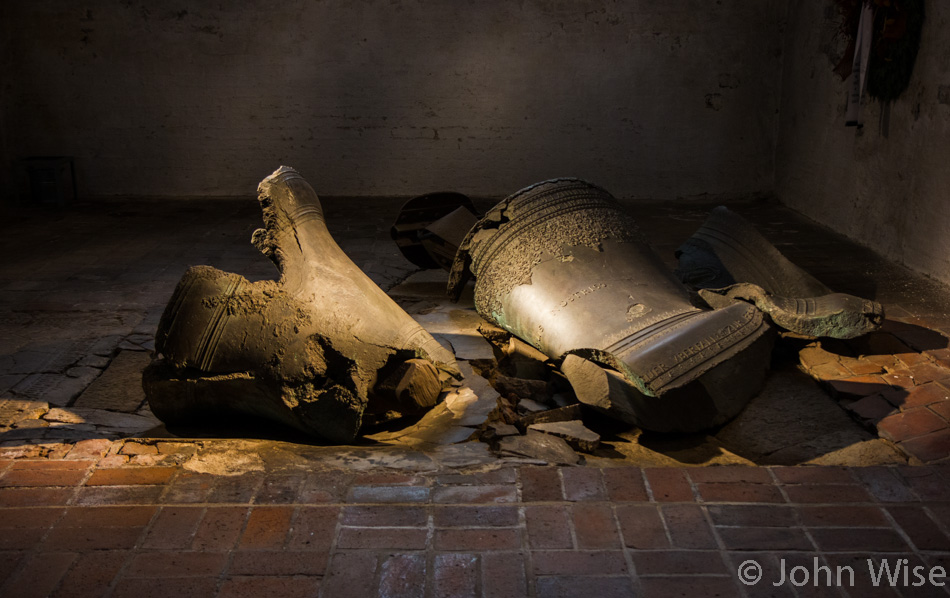The train track into the city center from Heddernheim is still on a weekend construction schedule, meaning it only goes so far before we have to transfer to a bus to bypass the traffic snarl. Today’s drop-off point is at Eschenheimer Tor (gate), an old part of the city wall that once surrounded Frankfurt. Sadly, little evidence of that part of history still exists, although you can see on a city map of Frankfurt where the old fortification used to sit – they have been turned into a sort of green belt. This is also where we’ll pick up the train again as we make our way to the Hauptbahnhof (main train station). We have a short walk towards the river looking for a particular house.
Olaf’s house is the one we are looking for, and we find him before we see his place. Standing in front of his building looking for us, it doesn’t look like this old friend has changed much at all. Upstairs in his large flat, we first meet his kids, Johnny and Lucy, and then his wife, Sylvia. A large table is set, and we are immediately invited to breakfast. Good thing that was scheduled as a part of our getting together. Like all of our meetings here in Germany, there are a few moments of getting reacquainted before falling into conversation as though time stood still during the intervening years, though the technology has dramatically shifted.
I first met Olaf back in 1989, maybe earlier, but my foggy memory can’t be sure. He was living down the street from us on Glauburgstrasse with To and Roman. Roman was and still is a musician. At the time, his project was called Schaum Der Tage, and To was a member. Through Olaf, I would also meet Uwe Schmidt, now known as Atom™. Just as importantly, maybe more so, Olaf gave me a copy of “No Sense Of Place – The Impact Of Electronic Media On Social Behaviour” by Joshua Meyerowitz; still one of my all-time favorite books. When Caroline and I got our first copy of Imagine (3D software) for the Amiga, Olaf was right there over our shoulder, curious about the entire process. After we moved to PC and Windows 3.0 and attended Cebit in 1990, we were given a free copy of 3D Studio ver. 1.0 by Autodesk, who apparently liked our story of what we’d accomplished so far. This would start a relationship with 3D software that would guide Olaf’s career.
After breakfast, Sylvia and Johnny had to leave for soccer practice. Lucy entertained herself in another room, and Caroline, Olaf, and I spent the next hours talking about social responsibility, education, technology, and virtual reality. There was little time for nostalgia as we only had four hours to cover the past 18 years, but what we did get to share left Caroline, and I encouraged and happy that we’d had this opportunity to spend the first part of the day with Olaf and had the chance to meet his family.
We left Olaf’s walking along the river with the idea of visiting the Architectural Museum, as I’ve been looking for books that detail Germany’s town centers. So far, we’ve not had any luck finding such a book, and it appears they may only be available from souvenir shops in the cities themselves. The reason behind this need has to do with the project I’ll be working on when I get back to the States. It involves virtual reality and the Oculus Rift, which I hope will be arriving shortly after our return. On the way to the museum, we passed this Renault Twizy, a two-person electric car. Watching it scoot along, we couldn’t help but want one. Wikipedia shows that it costs about $8,000, has a range of about 61 miles, and gets along at nearly 50mph. The museum was another dead end; nothing about the architecture of Middle Ages Germany. One more stop to make this morning, this one to visit Jutta. We only had a couple of hours with my mother-in-law, but she’s always happy to see us and still can’t believe we’re here.
Time to head back to Stephanie and Klaus’s. Today, we are meeting Klaus’s brother and his family. While we were away, Klaus (a terrific cook we are learning) made a cake with a bunch of fresh fruit. Shortly after we returned the Meyer’s arrived, also with a homemade cake. Michael is Klaus’s younger brother. He’s married to Isabella, whose family is originally from Spain. Their two children are twins named Yanik and Emilia.
After cake and coffee, the eight of us headed out for a walk so the four kids (including my wife) could go out and play. This little scooter proved valuable on another day, as parking is often some distance from the house due to a lack of available spots. Caroline needed something from the car, and Stephanie suggested she take Katharina’s scooter. I do believe if we lived within scootering distance from work, Caroline would have one of these in Phoenix.
Not only is the train stop nearby, but the grocery and a pizza place too, a small stream and green belt also run through the community. To get to this lush setting, we only walked a few minutes up the street before being greeted by this surprise. Surprise because here we are a few weeks into our trip here and we are just now learning of it.
Let me update this to FIVE kids. Klaus dared sit down on the “Crazy Spinny Vomit Inducer Thingy” and allowed me to do my best spinning him so fast that centrifugal force nearly launched him into a neighboring country. Just before the flight (and my attempt to capture the moment Klaus became an astronaut), he put down a foot to brake himself. This probably doesn’t require stating the obvious, but Katharina was hysterical with laughter watching Dad spinning at hundreds, if not millions, of revolutions per minute.
It’s easy to believe that Katharina has really enjoyed getting to know her aunt Caroline. The two of them have spent as much time together as our busy schedule has allowed. Just nine days after we leave, Katharina will become a teenager, so the next time we see this happy, well-adjusted niece of Caroline’s, she’ll be well on her way to being a young lady. It’s been great getting to know her a little while she’s still so innocent and happy. If only all of us could be so excited and enthusiastic about our time in life.
While the big kids played, the younger ones had no problem entertaining themselves. At this age, Emilia and her brother Yanik are amazed by everything around them, and it’s obvious how busy Isabella stays as she pushes, prods, and pulls them from potential danger. Though at times, like this one in the sandbox, we all get to sit back and watch them play.
I could have Photoshopped this to make it really look like Stephanie was knuckle-deep with her finger in her nose, but I thought better of it and decided to leave it looking like maybe she was covering her mouth while coughing, which she wasn’t. She’s wearing two pairs of glasses, as all moms have extra eyes in which to watch their children when they think they can hide from mom’s all-knowing vision of everything they do.
And this is the reason mothers need extra eyes. Yanik considers his options as he watches the intriguing, sparkly, fast-moving water rush by. He, Katharina, and Emilia had been lying down on a small bridge, dipping their hands into the water underneath them. Well, if this was so much fun, maybe getting in the stream would be great fun, too. Not if you’re Isabella; Mom was on constant vigil as he tempted fate by getting just an inch or two from the stream when he could. The photo is of him before he got close; here, he’s still far away. In a moment, he was but a grass blade away from taking a swim.
After a couple of hours of walking through the park and playing, it was nearly time to bid farewell to the Meyer family. It’s been a great afternoon getting to know a little about Klaus’s brother and his family. Before they left, there was some time left for scooter races and even time for Michael to try riding Katharina’s Wave Board. So far, this has been a perfect day.
How to put the icing on perfection? A perfect meal, that’s how! Klaus, Stephanie, Katharina, Caroline, and I took the train one stop back towards Frankfurt city center and then walked the rest of the way to Zur Golden Kron (The Golden Crown) restaurant. From the white asparagus soup to the Austrian-style dessert, our dinner in one of Klaus’s favorite places was amazing. And now it really has been a perfect day from start to finish.
